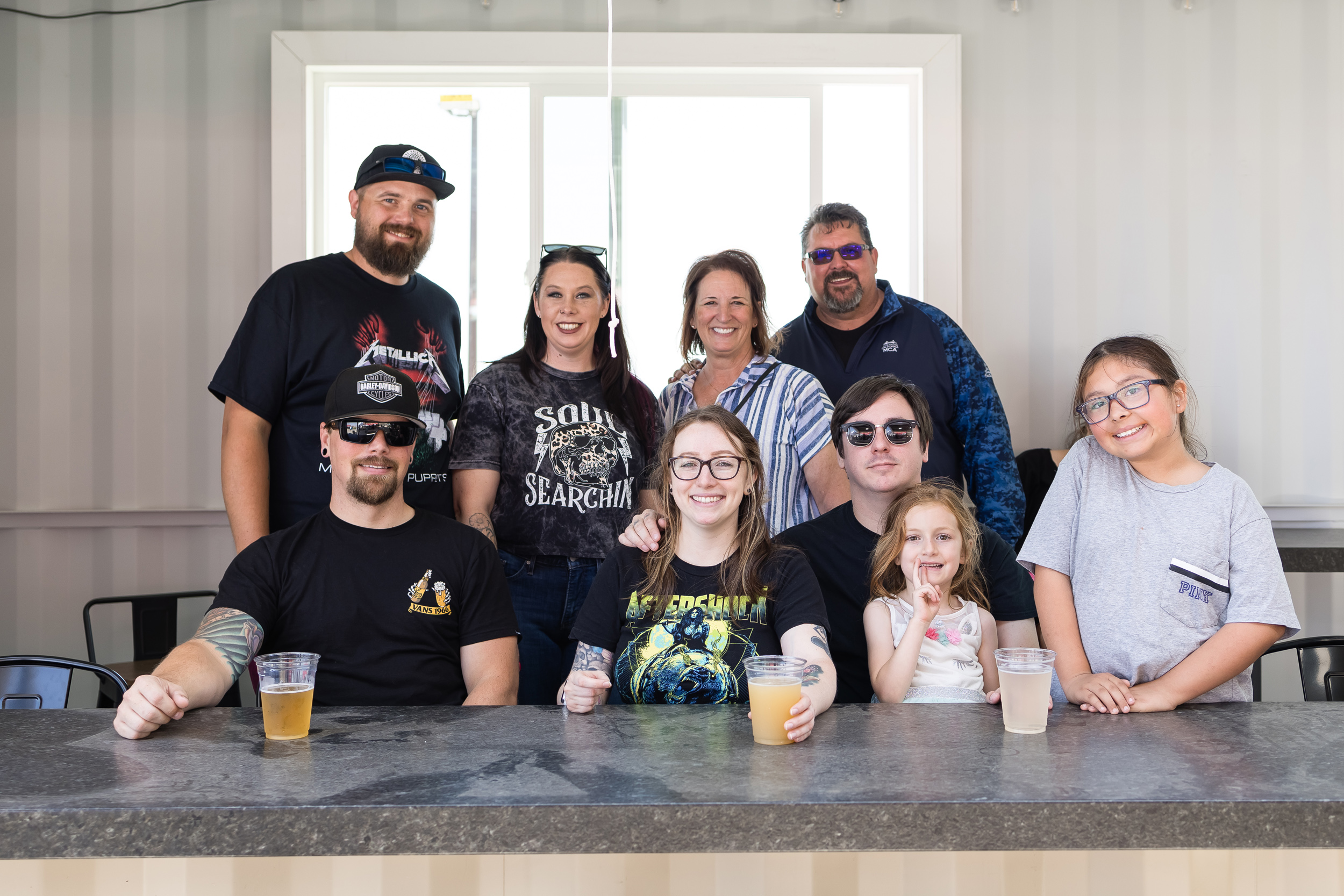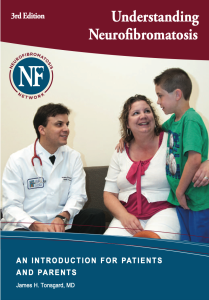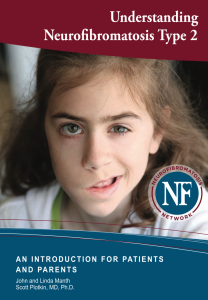What is NF?
Neurofibromatosis, pronounced neuro-fibroma-tosis, is a genetic disorder of the nervous system that causes tumors to form on the nerves anywhere in or on the body at any time. NF affects all races, all ethnic groups and both sexes equally. NF affects more people than Cystic Fibrosis and Muscular Dystrophy combined!
There are three distinct forms of neurofibromatosis: NF1, NF2 and schwannomatosis.
To assist you in your search for information about NF we have provided the information below as well as many Useful Links.


Neurofibromatosis Type 1
Neurofibromatosis causes unchecked growth of tissue along the nerves. This can put pressure on affected nerves and cause pain, severe nerve damage, and loss of function in the area served by the nerve. Problems with sensation or movement can occur, depending on the nerves affected. The condition can be very different from person to person, even among people in the same family who have the NF1 gene.
The “coffee-with-milk” (café-au-lait) spots are the hallmark symptom of Neurofibromatosis. Although many healthy people have 1 or 2 small café-au-lait spots, adults with 6 or more spots greater than 1.5 cm in diameter are likely to have Neurofibromatosis. In most people with the condition, these spots may be the only symptom.
Diagnostic Criteria For NF 1
Two or more of the following:
- Six or more café-au-lait spots 1.5 cm or larger in post-pubertal individuals, 0.5 cm or larger in pre-pubertal individuals
- Two or more neurofibromas of any type or one or more plexiform neurofibroma
- Freckling in the axilla or groin
- Optic glioma (tumor of the optic pathway)
- Two or more Lisch nodules (benign iris hamartomas)
- A distinctive bony lesion: dysplasia of the sphenoid bone or dysplasia or thinning of long bone cortex
- A first-degree relative with NF1
Effects Of NF 1
Neurofibromatosis type 1 (NF-1) is an autosomal dominant genetic disorder that causes tumors to grow on the covering of the nerves anywhere in the body at any time. The disorder affects 1 in 2,500 to 3,000 males and females of all races and ethnic groups. The NF-1 gene is located on chromosome 17.
Other symptoms may include:
- Blindness
- Seizures
- Freckles in the underarm or groin
- Large, soft tumors called plexiform neurofibromas, which may have a dark color and may spread under the surface of the skin
- Pain (from affected peripheral nerves)
- Small tumors of the skin called nodular neurofibromas
Click here to DOWNLOAD Dr. Tonsgard’s Booklet “Understanding Neurofibromatosis”
Resource
Understanding Neurofibromatosis
Dr. James H Tonsgard
Neurofibromatosis Type 2
Neurofibromatosis type 2 (NF 2) is a disorder characterized by the growth of noncancerous tumors throughout the nervous system. The most common tumors associated with Neurofibromatosis type 2 are called vestibular schwannomas or acoustic neuromas. These are benign, usually slow-growing tumors that develop from the balance and hearing nerves supplying the inner ear.
If tumors develop in other parts of the brain or spinal cord, signs and symptoms vary according to their location. Complications of tumor growth can include changes in vision or sensation, numbness or weakness in the arms or legs, and fluid buildup in the brain. Many people with NF2 have posterior sub capsular cataracts in one or both eyes, often beginning in childhood.
NF2 can cause deafness, severe balance problems, facial nerve paralysis, spinal cord compression, swallowing difficulties and/or eye function complications. Autosomal dominant disorders, approximately 50% of the cases are inherited. This means that if one parent has NF2, any child of that parent has a 50-50 chance of having it. The other 50% of the cases are accounted for by a new mutation.
Diagnostic Criteria For NF 2
Neurofibromatosis 2 (NF 2) is distinguished by multiple brain and spinal tumors that can cause deafness, severe balance problems, facial nerve paralysis, spinal cord compression, swallowing difficulties or eye function complications. Neurofibromatosis 1 and Neurofibromatosis 2, share the same name, but are very different disorders
Although NF-2 is an autosomal inherited disease, it is also important to understand that 50% of the cases are “sporadic” – meaning it does NOT have to be inherited to originate.
Confirmed (Definite) NF2:
- Bilateral vestibular schwannomas (VS) (also known as acoustic neuroma)
Presumptive (Probable) NF2:
- Family history of NF2 (first degree family relative) plus:
- Unilateral VS or any two of the following:
- dmeningioma, glioma, schwannoma, juvenile posterior subcapsular lenticular opacity, juvenile cortical cataract
Individuals With The Following Clinical Features Should Be Evaluated For NF2:
- Unilateral VS plus at least two of any of the following: meningioma, glioma, schwannoma, juvenile posterior subcapsular lenticular opacities/juvenile cortical cataract
- Multiple meningiomas (2 or more) plus unilateral VS or any two of the following: glioma, schwannoma, juvenile posterior subcapsular lenticular opacities/juvenile cortical cataract.
Effects Of NF 2
Neurofibromatosis type 2 (NF 2) is an autosomal dominant genetic disorder that causes tumors to form on the nerves of the central nervous system, in the brain, and on the spine. It affects one in 25,000 males and females of all races and ethnic groups. The NF 2 gene is located on chromosome 22.
Click here to DOWNLOAD the booklet “Understanding Neurofibromatosis Type 2
Resource
Understanding NF Type 2
John and Linda Manth & Scott Plotkin, MD, PhD
Schwannomatosis
Schwannomatosis is estimated to occur in 1 in 40,000 births. The inheritance pattern of Schwannomatosis is not well understood. The risk of transmitting the disorder to offspring is about 15%. Schwannomatosis symptoms usually first appear in adulthood.
Schwannomatosis Is Characterized By:
- Multiple schwannomas (never sheath tumors) without evidence of vestibular schwannoma
- Pain associated with the schwanomas
- Symptoms possibly limited to one area of the body
Diagnostic Criteria For Schwannomatosis
- Individual is age over 30 years
- AND has two or more non-intradermal Schwannomas, at least one with histological confirmation
- AND has no evidence of vestibular tumor on high-quality MRI scan
- AND has no known constitutional NF2 mutation
Prognosis For Schwannomatosis
Anyone with schwannomatosis experiences some degree of pain, but the intensity varies. A small number of people have such mild pain that they are never diagnosed with the disorder. Most people have significant pain, which can be managed with medications or surgery. In some extreme cases, pain will be so severe and disabling it will keep people from working or leaving the house.
How Is Schwannomatosis Treated?
There is no currently accepted medical treatment or drug for schwannomatosis, but surgical management is often effective. Pain usually subsides when tumors are removed completely, although it may recur should new tumors form. When surgery isn’t possible, ongoing monitoring and management of pain in a multidisciplinary pain clinic is advisable.
Useful Links
The Neurofibromatoses National Institute of Neurological Disorders and Stroke (NINDS)
Webinars About NF
- Recent webinars hosted by the NF Network regarding NF1, NF2, and Schwannomatosis
NF Clinics, Physicians And Hospital Links
- Find a Doctor
- Clinical Trials- Neurofibromatosis
Insurance Information
- National Organization of Rare Diseases (NORD) Insurance Guide by State
Support
- Want to chat online with others who are living with NF? Visit the NF Support Community.
- See our list of regional representatives to speak to someone in your area.
National NF Programs And Fundraisers
- NF Buddies
- Doodle4NF
- Beauty Mark Nation
